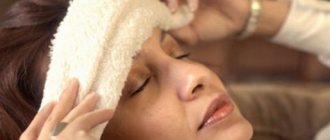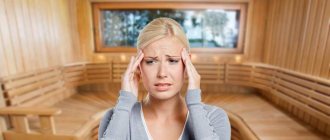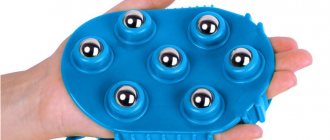Most people are sure that the bathhouse is a source of health. However, troubles often arise associated with bath procedures. In previous articles we discussed the following questions: why do you have a headache after a bath, why do your eyes fester? In this article we will look at cases when and why the skin deteriorates after a bath, why red spots appear after a bath, swelling, rash, itching, pimples, etc.
Causes of headache after a bath
If you have a headache after a bath, there may be a number of reasons for this:
- Lack of oxygen in the steam room due to lack of ventilation
- Using unsuitable stones in the heater that emit harmful fumes during heating
- Poisoning of the body by carbon monoxide emitted by the stove
- Excessive thermal loads, overheating
- Allergic reaction to herbal infusions used in the bath, or broom leaves
- Pinched nerves of the cervical spine, the pain from which worsens with excessive stress on the body
- Cerebrovascular diseases
- Overwork, etc.
If we are talking about the first three points, then changing the bathhouse will help get rid of headaches once and for all. If it comes to your own steam room, then it’s worth thinking about some design changes or a small update. Perhaps now is the time to take care not only of your condition, but also of the health of loved ones who are also experiencing this negative impact.
In general, going to the bathhouse is a very heavy physical load on the human body. And for an “untrained” person this is a huge stress. In addition, the situation is aggravated by the addiction of many modern people to bad habits. All this significantly weakens our immunity. You should not drink alcoholic beverages before going to the bathhouse. Headache can also occur in a person who smokes a lot. Alcohol and cigarettes in combination with sauna overheating will bring nothing but harm to the body.
A heavy dinner can also cause the described illness. You should not go to the steam room earlier than 2 hours after eating. Although it will also be difficult for a hungry body to withstand temperature stress. The ideal state is that you are not yet hungry, but you are no longer burdened with a heavy stomach. A good option is to take fresh fruit or a light vegetable salad before the bath.
One of the causes of headaches can be preliminary physical exercise or a hard day at work, after which the body needs rest, and not additional stress on the heart.
It is advisable to spend such an evening calmly at home, lying on the sofa and reading a book. Summer residents often make a similar mistake: after working in the garden, without leaving the beds, in the evening they go to a hot bath, hoping to relax and unwind, but only get a sharp headache in addition to fatigue. If you still want to take a steam bath, then you should reduce the time of the procedures and the heating temperature of the air.
The reasons listed above are the most harmless that could be given as an example. Pain indicates that there are abnormalities in the body, the restoration and diagnosis of which should be handled by a professional. Firstly, there may be problems with blood pressure. The circulatory system may not cope with the blood flow, and the vessels of the head may become clogged for some time. The disadvantage of diagnosing such a disease today is the inability to measure intracranial pressure, which increases during periods of acute pain, without special instruments. Although there is one solution for this case too.
A headache in the bathhouse is a signal for you; you should not put off visiting a doctor.
Taking an aspirin tablet before a bath can save you from unpleasant consequences. Secondly, there may be individual illnesses that worsen during a visit to the steam room: organic brain diseases, migraines, etc.
Methods to combat headaches
In some cases, headaches can be managed. And the simplest and most accessible in this case are traditional medicine recipes, which, however, should also be discussed with your doctor. Sometimes simple fresh strawberries or lingonberries, eaten in a bathhouse, can relieve an illness. Viburnum juice also has a particularly beneficial effect on the body in this case.
In some situations, aromatherapy techniques can be used. This is the safest method of treatment. For the bath you will need mint (5 drops), chamomile (2 drops) and orange (2 drops) oils, which must be added to a bowl of water and served on hot stones. It is this steam, inhaled throughout the entire procedure, that will help get rid of discomfort after the bath.
You can make one of the herbal vitamin drinks. For example, 1 spoon of St. John's wort is poured into 1 glass of very hot water and boiled for 15 minutes. After which it is filtered and drunk in a bathhouse in 3 batches. Or you can use another recipe: 1 tablespoon of elderberry is infused in a glass of boiling water for 15 minutes. It is also taken in a bath, half a glass with 1 teaspoon of honey. It is advisable to take the infusion 3 times during the entire procedure.
Thus, there are many reasons why a headache can be given after a bath. But you need to remember that visiting a steam room, if you approach the process “wisely,” brings great benefits. The main thing is to properly prepare the body, take care of real rest for yourself, and not about additional stress for the body. And then no illness will darken your evening.
Source: www.otekstop.ru
The most common forms of ill health
In this section, we will consider the most typical and common forms of poor health as a result of taking bath procedures.
Heatstroke
This is the body’s reaction to overheating, when, in conditions of high ambient temperature, the body is not able to independently carry out adequate thermoregulation.
The main symptoms of heat stroke are:
- Redness of the skin - it becomes drier and hotter;
- Rapid breathing, shortness of breath;
- Nausea, vomiting, dizziness, visual hallucinations, which manifest themselves in the illusion of motion of stationary objects, “flickering” before the eyes;
- Muscle pain and spasms;
- Rapid, weak pulse;
- Disturbance, and sometimes complete lack of sleep;
- In severe cases, loss of consciousness, convulsions.
Attention! Heat injury is especially dangerous for people suffering from cardiovascular diseases. In particularly severe cases, heat stroke can result in cardiac arrest.
Heat stroke occurs in conditions of high air temperature and high humidity. They often precede it, and as a result, aggravate the negative impact: high physical activity, overwork, stress.
Carbon monoxide poisoning
A very dangerous form of illness as a result of taking bath procedures, which, unfortunately, very often occurs at the everyday level. We strongly recommend that you familiarize yourself with the manifestations of poisoning and prevention here.
Fainting
This is a short-term loss of consciousness associated with a situational disturbance of cerebral blood flow.
In a bathhouse, fainting is most often caused by insufficient oxygen in the blood, as a result of being in hot and humid rooms with insufficient ventilation.
Loss of consciousness is usually preceded by a state of general malaise, nausea, blurred visual perception of the environment, and ringing in the ears. Weakness, yawning, and trembling in the lower extremities develop. The victim turns pale and sweats.
After loss of consciousness, the skin becomes ashen-gray in color, the pressure drops sharply, the pulse has a thread-like character, is very weakly palpable, can be rapid, or, on the contrary, rare. The muscles relax, the pupils are greatly dilated, and their reaction to light decreases. As a result of a decrease in muscle tone, the tongue may sink and the body may block the respiratory tract.
Causes of edema
This phenomenon is the main result of fluid retention in the body. Poor lymph circulation also contributes to swelling. If there are no obvious health problems (and only a doctor can determine this), then, most likely, there are errors in nutrition. In particular, we can safely say that there is a lack of potassium in the body and a large amount of sodium. This happens if there is more salt in the diet than normal.
Fluid retention can also be caused by fried, smoked foods, various kinds of preserves, sauces and even cheese. The combination of salt and sugar is especially dangerous. If you add more fat to this, then swelling cannot be avoided. That's why people prone to fluid retention in the body are better off avoiding store-bought sweets. This also applies to alcohol and everyone's favorite coffee. The insidiousness of these drinks is that at first they dehydrate the body, and then still retain water in the body.
It is worth remembering that there is a norm for salt consumption. Exceeding the norm for every 10 g leads to a retention of 1 liter of fluid in the body.
In the evening, lymph circulation slows down. If you drink water at this time, the liquid will definitely not have time to leave the body. Also, during dinner you need to limit your salt intake, otherwise the risk of morning edema increases. The movement of lymph also depends on the degree of human activity. The more movement you have throughout the day, the less likely your body will become swollen. To avoid morning swelling, it is not recommended to lie in bed for a long time after waking up.
How to get rid of puffiness: general tips
First of all, it is necessary to improve lymph circulation. This can be done with a special lymphatic drainage massage of the whole body. It can be manual or hardware; the effectiveness of the procedure practically does not depend on it. The course consists of 10-15 procedures depending on the severity of edema. The frequency of massage is from 1 to 3 times a week. In addition to improving lymph circulation in the body, this procedure will speed up the metabolic process and also quickly remove toxins from the body.
Other types of massage have the same effect, for example, acupressure or using heated stones, as well as algae wraps.
Other methods will help relieve swelling at home:
- contrast shower, and it must be directed from bottom to top;
- sauna or bathhouse; additionally, between entering the steam room, you can massage the body with a special brush in the direction of the lymph flow;
- warm-up exercises, since swelling of the body can be the result of a lack of muscle activity: vigorous walking, jogging, swimming, but only regular exercise;
- taking diuretics, but only mildly and after consulting a doctor;
- therapeutic massage of swollen body parts;
- a warm bath with sea salt, and the water temperature should be warm, not hot.
In addition, to get rid of swelling, it is recommended to avoid tight clothing and shoes. This is because the added pressure on the swollen areas can restrict the flow of blood to those parts. People prone to swelling should completely avoid wearing tight belts, stockings, garters, high-heeled shoes, rings and other similar things.
Positive effects of baths on human skin
Bath procedures (steam room) are those in which the main effect is sweating due to the effect of warm air on the body.
In a steam room, the body releases heat to the external environment through sweating and evaporation of moisture with exhaled air. The degree of evaporation from the surface of the skin and mucous membranes depends on their temperature: the lower it is, the less evaporation. In a bathhouse, when the skin temperature rises, sweating increases almost 2 times, and when the entire surface of the body sweats, the degree of body cooling increases approximately 30 times compared to body cooling under normal conditions.
The skin of the steamer is moisturized already upon entering the steam room due to steam condensation on it. Sweating begins after 8-10 minutes in the steam room. And for those who are accustomed to the steam room, sweating may begin as early as 3-4 minutes in the steam room.
Already at the beginning of your stay in the steam room, the activity of the sweat glands increases, and the number of active sweat glands in a person reaches 100 per 1 cm2.
Body weight when visiting a bathhouse (sauna), when using a steam room, decreases due to sweating, depending on the duration of stay in the steam room, the air temperature in the steam room, body position (sitting, lying down), the state of the nervous system, water-salt metabolism, gender ( According to some scientists, men sweat more than women). In persons accustomed to the bathhouse (sauna), the loss of body weight averages up to 20 g/m2, and in those who have not previously visited the bathhouse - up to 13 g/m2.
The total sweat production in the steam room usually reaches 20-30, and sometimes 40 g/min. This depends on the air temperature in the steam room, the duration of exposure to hot air, the number of times you enter the steam room and the use of a broom.
Significant evaporation of sweat occurs when the temperature of the steamer’s skin reaches 41° C. If the bath is overheated (4-5 visits to the steam room), sweating stops almost completely.
It was believed that taking a large amount of liquid before a bath would lead to increased sweating. It turned out that sweating in such cases increases slightly. From a therapeutic point of view, you should not consume a lot of moisture before a bath, as this only increases the load on the kidneys. The fact is that the liquid necessary for the formation of sweat is supplied to the sweat glands by blood vessels, therefore an increase in blood flow in the skin using mechanical (brush, broom) or reflex (thermal foot baths) effects increases sweating.
With sweating, swelling decreases or disappears altogether due to the transition of fluid from the interstitial space into the blood. At the same time, substances move from tissues into the blood. The removal of these substances from the blood is carried out by the liver, kidneys and, to a lesser extent, the sweat glands.
Sweat analysis shows that some mineral salts are excreted from the body through sweat. 1 liter of sweat contains 2-3 g of sodium chloride and 0.4-0.8 g of potassium. Eating salty foods quickly compensates for the loss of sodium chloride, and the loss of potassium can be compensated for by eating vegetables and herbs. The iron content in the sweat of healthy people reaches 1.6 mg per 1 liter of sweat. It has also been found that increased amounts of copper are excreted from the body through sweat, especially in those who suffer from Wilson's disease, in which this element is deposited in excess in the tissues. Therefore, a bath (sauna) is recommended for such patients as an auxiliary method of therapy.
With sweat, the body also releases: uric acid (this is good), lactic acid, amino acids (some amino acids are actively secreted by the sweat glands). Some hormones and vitamins are also released with sweat.
So, the skin, along with the mucous membrane of the upper respiratory tract, is the main organ affected by bath (sauna) factors, that is, an acceptor and mediator of its effect on other organs and the entire body as a whole.
The skin is not only the outer shell of the body in contact with the environment, but also a highly differentiated organ that performs numerous functions that are important not only for the skin itself, but also for the entire organism. The skin and its appendages contain nerve endings, blood vessels, lymphatic vessels, sweat and sebaceous glands. The skin has close connections with other organs and systems.
Here it is appropriate to consider those skin functions that are directly related to the operating factors of the bath (sauna).
The protective function of the skin is associated with the nature of the anatomical structure of the skin and subcutaneous fat layer, with the biochemical structure of its surface, as well as with metabolic, secretory and other features.
The skin protects the body from the following influences: mechanical - due to its density and elasticity; physical - due to density, pigmentation and electrical properties;
chemical - due to the density, impermeability and biochemical properties of the surface (resistance to acids and alkalis due to neutralizing abilities); biological (microbial) - due to the integrity and biochemical qualities of the skin surface, as well as the production of protective substances, vitamins and enzymes.
Heat and other physiotherapeutic factors (including baths) have a positive effect on peripheral blood circulation, improve trophism of the skin and its appendages, stimulate its functions, regeneration of the epidermis and subcutaneous fat layer, metabolic, secretory and immune functions. Ultimately, there is an improvement and normalization of impaired skin functions and regression of skin diseases such as dermatosis.
The skin performs the function of thermoregulation, which is carried out under the control of the nervous system, which affects changes in blood flow in the skin, sweat secretion and evaporation. The ambient temperature is perceived by skin thermoreceptors, impulses from them reach the central nervous system and temperature centers of the hypothalamus, and from them are transmitted to the executive thermoregulatory organs.
The skin performs an information function. Being an information organ, the skin has a significant receptor area in which there are sensitive receptors that perceive heat, cold, pressure, burning, itching, pain and other sensations, with the help of which adaptive protective and other mechanisms in the body are carried out. A visit to the bathhouse has a positive effect on the skin: it reduces itching and related unpleasant sensations.
The secretory function of the skin is carried out by its appendages: sweat and sebaceous glands. The secretion of these glands, together with keratin proteins and exfoliated epidermal cells, forms a physiological protective layer of the skin surface with numerous protective properties: resistance to acids and alkalis with neutralizing, antimicrobial and antifungal and other qualities. The bath helps improve the activity of skin appendages.
The skin has reflex abilities. Neurovascular reactions of the skin make it possible to determine the state of the autonomic nervous system, its reactivity, and the ability to form vasoactive substances. They arise in response to external (mechanical, physical and chemical) and internal (metabolic, toxic, neuropsychic) influences. Heat, cold and mechanical influences when staying in a bathhouse (sauna) cause the formation of vasoactive substances and affect the tone of the autonomic nervous system.
Not the least important role is played by the barrier function of the skin , thanks to which the skin, on the one hand, protects the body from the penetration of harmful substances, which is very important in professional, toxicological and toxic-allergic relations. On the other hand, the skin perceives, resorbs, deposits and transports a number of substances, both harmful and drugs. In addition, certain substances are released from the body through the skin. These processes can go in both directions, with the exception of oxygen, which penetrates only inside.
The skin is capable of resorption, which should be taken into account in dermatology when applying medications, balneoclimatotherapy, mud treatment, introducing substances into the body using galvanic current, and massage. An increase in peripheral blood circulation and skin temperature, as well as sweating and hydration of the epidermis under the influence of the temperature and mechanical effects of a bath (sauna) increase the resorption capacity of the skin and its permeability to drugs, in particular those used in dermatology.
Bath (sauna) has a positive effect on metabolic processes, water-salt metabolism, the formation of vitamins, vasoactive substances, tissue hormones, enzymes, immune processes, pigmentation, etc.
The effect of a bath (sauna) on the skin is mainly due to contrasting temperature conditions. Increasing the supply of oxygen to the skin as a result of accelerating blood flow and improving skin respiration during hyperemia (absorption of oxygen from the atmosphere) stimulates oxidative processes in the skin. The supply of protective substances to the skin increases, the phagocytic ability of leukocytes, enzyme activity, and membrane permeability increase. When skin temperature rises, metabolism increases 2-3 times. An increase in blood flow in the skin helps to accelerate the resorption of inflammatory infiltrates, the removal of pathological metabolites to excretory organs (kidneys, sweat glands), and their detoxification in the liver.
Intense sweating and perspiration contribute to the hydration of cells of the stratum corneum, desquamation of hyper- and parakeratotic scales in squamous dermatoses. Under the influence of the steam room, the ducts of the sweat glands open in case of follicular hyperkeratosis. The release of retained sweat from the excretory ducts and intercellular spaces of the epidermis increases.
It is known that scratching during skin itching worsens the course of dermatosis. Therefore, in the treatment of dermatoses, the main efforts are aimed at eliminating itching. A bath (sauna) helps relieve itching. Its disappearance is the most sensitive subjective indicator of the success of treatment and has not only psychotherapeutic significance, but also reflects positive morphological changes.
An increase in blood flow in the skin, hydration of the cells of the stratum corneum, and improvement in the permeability of the epidermis under the influence of the steam room create conditions for improving skin permeability and the therapeutic effect of dermatological medications used externally.
The bath affects the tone of the autonomic nervous system, the metabolism of skin sugar, lipids, uric acid and nitrogenous compounds, and water-electrolyte metabolism, which are disrupted in dermatoses. Alternating high and low temperatures in the bath can have a positive effect on vasomotor adaptation during temperature fluctuations, dermatoses with impaired peripheral blood circulation (cold feet and hands, vasospasm, etc.).
The bath has a pronounced cosmetic effect. It has long been believed that skin is a mirror of health. Its color, plasticity, strength, moisture and greasiness, the thickness of the skin and subcutaneous fat are the signs by which not only the condition of the skin, but also the body as a whole is judged. Pink color of the skin is considered a sign of its good condition. It is due to good blood supply. The bath, like some other physiotherapeutic procedures that improve the trophism of the skin and its appendages, has a positive effect on its functions and ultimately provides a cosmetic effect without signs of intolerance or allergic sensitivity.
It is believed that the bath (sauna) improves the trophism of hair follicles and improves hair growth. By stimulating the sebaceous and sweat glands, the lubrication and elasticity of dry, brittle hair improves.
It is known that the occurrence of many dermatoses is in a pathogenetic connection with the state of the internal environment of the body, the central and autonomic nervous system, and with disruption of the functions and systems of the body. Bath (sauna) is a form of training of thermoregulatory mechanisms. Some dermatoses (psoriasis, atropic dermatitis) have a characteristic seasonal course with worsening in winter, especially during thaws. This is due to the body’s poor adaptation abilities to climate change.
Bath (sauna) increases the body's resistance to viral and bacterial infectious diseases, catarrhal conditions caused by cooling. It is known that it is with them and sore throats that exacerbation of psoriasis often occurs.
There is a positive effect of the sauna bath on the course of allergic diseases. The bath, affecting metabolic processes, excretory and detoxification organs, the nervous system, has a therapeutic effect on dermatoses that are associated with disruption of the functioning of internal organs.
Under the influence of the bath the following improves:
physical well-being, sleep, appetite, emotional stress decreases or disappears altogether, depressive disorders weaken or disappear. All this, along with other results, gives a positive psychotherapeutic effect for dermatoses.
Quite a lot of material has been accumulated on the positive effects of baths (saunas) for various dermatological diseases: eczema, urticaria, atropic dermatitis, furunculosis, psoriasis, peripheral circulation disorders, residual effects after wounds, non-healing defects, acne, during cosmetic cleansing of the skin and some others.
On the topic of the article:
Find something else interesting:
Therapeutic diet
The first step is to reduce the amount of sodium in your diet. Remember that this element causes moisture to accumulate in various parts of the body. In addition to adding salt to food, it is worth remembering that there is a lot of it in the so-called “packet” food, as well as smoked meats and pickles. Therefore, such products should be abandoned.
If in the morning you notice swelling of the body and at the same time you are sure that there are no health problems and your health is normal, then it is recommended to completely avoid salt until the swelling is removed at home. In other cases, it is better to start treatment. This also applies to cases where swelling cannot be removed.
If you are prone to the formation of body edema, it is recommended to drink plain water without gas. Moreover, you should not limit the amount of liquid - this will help get rid of body swelling. Remember that one of the causes of swelling can be dehydration. In this way, the body tries to make reserves for the future. If you eat a slice of lemon or cucumber after a glass of water, the diuretic effect of taking the liquid will increase.
You should also avoid ready-made store-bought drinks, including juice. Even though these drinks are sweet, they do contain sodium. And this can cause disruption of lymph circulation.
You need to add foods that are fortified with magnesium to your diet. If this is not possible, then the pharmacy sells special magnesium supplements. The body's daily requirement for this element is 25 mg. In addition, you need to eat fresh vegetables and fruits and herbs every day. This will help remove excess moisture from the body, as well as normalize the functioning of the liver and kidneys. If you cannot relieve the swelling on your own, then you need to consult a doctor who, after examination, will prescribe treatment.
Recipes for anti-aging masks
Steamed and cleansed skin needs to be nourished and moisturized. Only then will it be possible to achieve a rejuvenating effect and get rid of small wrinkles. Here are recipes for masks suitable for this case:
- An ordinary cucumber can immediately provide nutrition and hydration to the skin. The vegetable is pre-grated on a coarse grater. The mask should be applied to the skin of the face after leaving the steam room. At the same time, the cucumber mass relieves redness and soothes flaky areas.
- For mature ladies, a mask of 1 teaspoon of honey, the same amount of carrot juice and 1 yolk is good. All components are mixed until smooth and the composition is applied to the face. To tighten pores and whiten your skin, you can add a few drops of lemon juice. After a quarter of an hour, you need to wash your face with clean water.
- A mixture of dried seaweed and fatty homemade cottage cheese gives a miraculous effect. The components are taken in equal parts, then the composition is mashed with a fork. For the effect, it is enough to keep the resulting paste on your face for 15-20 minutes.
Dry skin especially needs nutrition and hydration. Its owners can improvise and include components such as sour cream, olive and linseed oil, and honey in the masks . If the skin is oily, it is better to make lemon or aloe juice and egg white as the main components of the cosmetic product.
Cosmetical tools
Special stores sell products that are aimed at improving lymph circulation in the body. And this can help eliminate swelling in the body. The composition of cosmetics with a lymphatic drainage effect includes algae extract, red grapes, essential oils and caffeine. You can additionally stimulate lymph flow with a piece of ice.
In some cases, if swelling occurs, you should consult a doctor. In particular, if they appeared during pregnancy or after taking medications, are permanent or too painful, and a mark remains when pressed. In this case, treatment may be needed.
It is possible to relieve swelling of the body, although preventing the occurrence of this problem is even easier. If you are sure that you have a tendency to edema, it is better to avoid salt and alcohol. And, of course, don’t limit your night’s sleep.
Source: otekinfo.ru
Treatment of acne in a bath
reasons for the occurrence of acne , ranging from hormonal changes occurring in the body to improper skin care, insufficient cleansing of the pores, which results in blockage of the pilosebaceous ducts.
As a rule, even if the rash is caused not by external, but by internal processes in the body, the skin of the face can be helped by visiting a bathhouse.
And although the bathhouse does not stabilize the hormonal levels, it will not allow the disease to start due to clogged pores.











